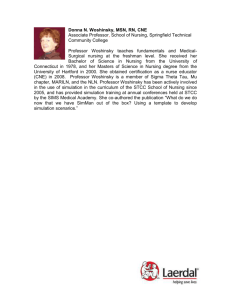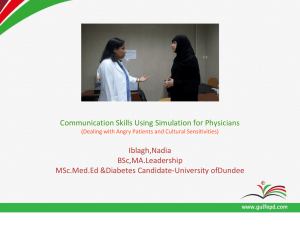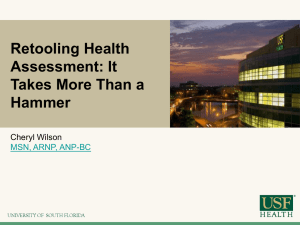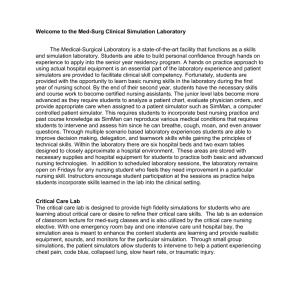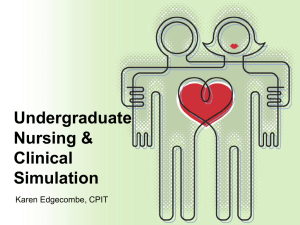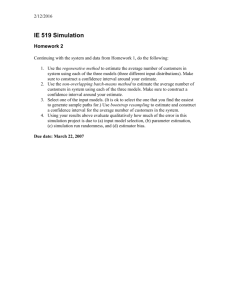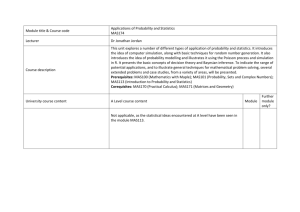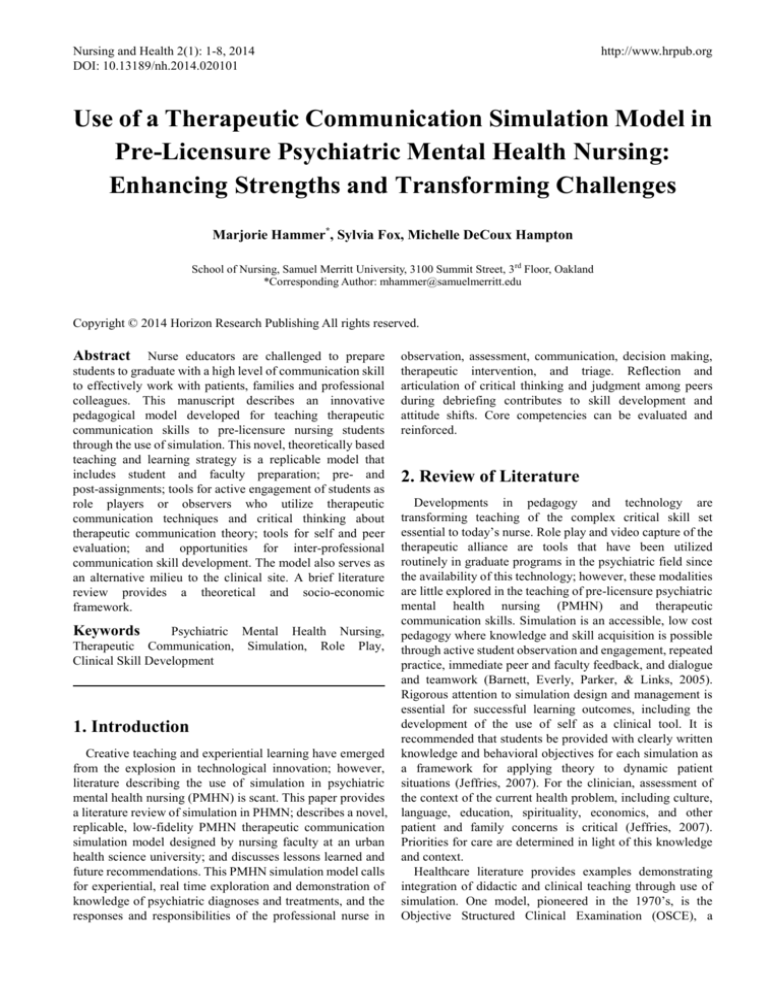
Nursing and Health 2(1): 1-8, 2014
DOI: 10.13189/nh.2014.020101
http://www.hrpub.org
Use of a Therapeutic Communication Simulation Model in
Pre-Licensure Psychiatric Mental Health Nursing:
Enhancing Strengths and Transforming Challenges
Marjorie Hammer*, Sylvia Fox, Michelle DeCoux Hampton
School of Nursing, Samuel Merritt University, 3100 Summit Street, 3rd Floor, Oakland
*Corresponding Author: mhammer@samuelmerritt.edu
Copyright © 2014 Horizon Research Publishing All rights reserved.
Abstract Nurse educators are challenged to prepare
students to graduate with a high level of communication skill
to effectively work with patients, families and professional
colleagues. This manuscript describes an innovative
pedagogical model developed for teaching therapeutic
communication skills to pre-licensure nursing students
through the use of simulation. This novel, theoretically based
teaching and learning strategy is a replicable model that
includes student and faculty preparation; pre- and
post-assignments; tools for active engagement of students as
role players or observers who utilize therapeutic
communication techniques and critical thinking about
therapeutic communication theory; tools for self and peer
evaluation; and opportunities for inter-professional
communication skill development. The model also serves as
an alternative milieu to the clinical site. A brief literature
review provides a theoretical and socio-economic
framework.
Keywords
Psychiatric Mental Health Nursing,
Therapeutic Communication, Simulation, Role Play,
Clinical Skill Development
1. Introduction
Creative teaching and experiential learning have emerged
from the explosion in technological innovation; however,
literature describing the use of simulation in psychiatric
mental health nursing (PMHN) is scant. This paper provides
a literature review of simulation in PHMN; describes a novel,
replicable, low-fidelity PMHN therapeutic communication
simulation model designed by nursing faculty at an urban
health science university; and discusses lessons learned and
future recommendations. This PMHN simulation model calls
for experiential, real time exploration and demonstration of
knowledge of psychiatric diagnoses and treatments, and the
responses and responsibilities of the professional nurse in
observation, assessment, communication, decision making,
therapeutic intervention, and triage. Reflection and
articulation of critical thinking and judgment among peers
during debriefing contributes to skill development and
attitude shifts. Core competencies can be evaluated and
reinforced.
2. Review of Literature
Developments in pedagogy and technology are
transforming teaching of the complex critical skill set
essential to today’s nurse. Role play and video capture of the
therapeutic alliance are tools that have been utilized
routinely in graduate programs in the psychiatric field since
the availability of this technology; however, these modalities
are little explored in the teaching of pre-licensure psychiatric
mental health nursing (PMHN) and therapeutic
communication skills. Simulation is an accessible, low cost
pedagogy where knowledge and skill acquisition is possible
through active student observation and engagement, repeated
practice, immediate peer and faculty feedback, and dialogue
and teamwork (Barnett, Everly, Parker, & Links, 2005).
Rigorous attention to simulation design and management is
essential for successful learning outcomes, including the
development of the use of self as a clinical tool. It is
recommended that students be provided with clearly written
knowledge and behavioral objectives for each simulation as
a framework for applying theory to dynamic patient
situations (Jeffries, 2007). For the clinician, assessment of
the context of the current health problem, including culture,
language, education, spirituality, economics, and other
patient and family concerns is critical (Jeffries, 2007).
Priorities for care are determined in light of this knowledge
and context.
Healthcare literature provides examples demonstrating
integration of didactic and clinical teaching through use of
simulation. One model, pioneered in the 1970’s, is the
Objective Structured Clinical Examination (OSCE), a
2
Use of a Therapeutic Communication Simulation Model in Pre-Licensure Psychiatric Mental
Health Nursing: Enhancing Strengths and Transforming Challenges
20-minute simulated encounter with a short debriefing. The
OSCE provides close encounters for the evaluation of
knowledge
base
and
cognitive,
communication,
psychosocial and technical skills (Linder & Pulsipher, 2008;
Kardong-Edgren, Starkweather, & Ward, 2008; Rauen, 2004;
Robertson, 2006; Rhodes & Curran, 2005). Students
demonstrate the ability to apply course concepts to practice,
think critically, intervene effectively, communicate
therapeutically and work as a team in a variety of settings.
Students report that the OSCE model increases their
knowledge, prepares them for clinical, and increases clinical
confidence. Simulation provides an opportunity to learn and
practice in a safe environment, and has been associated with
improvement in skills of communication and critical
judgment (Bambini, Washington, & Perkins, 2009). Students
may be required to complete a communication course prior
to admission to nursing school; bridging the gap between
theory and practice remains an issue (Kluge & Glick, 2006).
Medical students in a randomized controlled study of using
peer role play (RP) versus standardized patient (SP)
simulation to teach communication skills reported both were
highly acceptable and highly realistic; peer RP is less
expensive (Bosse et al., 2010).
The mind and heart of the simulation process is debriefing,
which engages the skills of self-reflection and discovery
(Kardong-Edgren et al., 2008). Harvard’s Debriefing
Assessment for Simulation in Healthcare (DASH) is a tool
helpful for assessing debriefing for diverse disciplines and
courses, educational objectives, and physical and time
frameworks (Simon, Raemer & Rudolph, 2009). The DASH
model, based on thirty-five years of research to improve
professional effectiveness through reflective practice,
recommends debriefing that promotes “a conversation… in
which participants explore, analyze and synthesize their
actions and thought processes, emotional states and other
information to improve performance in real situations…”
(Simon et al., 2009). Debriefing provides an opportunity for
students to think critically, discuss rationales for behavior,
discover what was done well and what could have been done
differently, and integrate lessons learned into their practice.
Critical skills for the nursing professional include the ability
to provide appropriate feedback and “rigorous reflection”,
rather than withholding thoughts and feelings to avoid
confrontation, hurt or defensiveness which can “perpetuate
medical mistakes and undermine patient safety…[in] the real
clinical environment” (Rudolph, Simon, Dufresne, &
Raemer, 2006, p.50). The DASH model provides a
framework of safety and rigor for student development of
these essential critical reasoning processes and ethical
behaviors (Simon et al., 2009). A central feature of DASH is
the concept of “debriefing with good judgment”: disclosure
of faculty judgments and trainee assumptions and rationales
for actions are pivotal to learning and growth (Rudolph et al.,
2006). Through the deconstruction of internal frames,
trainees engage in “… rigorous self-reflection… to reframe
internal assumptions and feelings, …recognize and resolve
pressing clinical and behavioral dilemmas raised by the
simulation, …and take action to achieve better results in the
future” (Rudolph et al., p. 49). A stance of advocacy and
inquiry sheds light on the judgment of the instructor and the
trainee, thus supporting critical, evaluative judgments in the
context of a trusting relationship.
While Nehring and Lashley’s (2004) comprehensive
international study found that simulation is rarely used in
psychiatric mental health nursing (PMHN) courses, reports
are emerging, including the use of SPs, static manikins, RPs,
high-fidelity manikins, and e-learning to increase therapeutic
communication skills. When Robinson-Smith, Bradley, and
Meakim (2009) utilized a convenience sample of nursing
students to evaluate the use of SPs in scenarios to teach
assessment skills, including the mental status examination
and a suicide risk assessment, students perceived that their
confidence, learning, and critical thinking improved. Davis,
Josephsen, and Macy (2012) utilized SPs for PMHN
simulation when clinical sites were lacking. Challenges
included the ability to recruit an adequate number of SPs and
to give helpful feedback. Hermanns, Lilly, and Crawley
(2011) used a model of a faculty-led simulation with a static
manikin to simulate an attempted suicide. The goal was to
immerse students in a realistic psychiatric-mental health
event in a safe, structured environment. Faculty was present
throughout to provide guidance, questions, prompts, and
cautions. Students supported the use of simulation in PMHN
as a teaching/learning strategy: “Now I know what to do”
and awareness of challenges (Hermanns et al., p. e44).
Sleeper and Thompson (2008) designed and implemented a
simulation for PMHN students to increase their confidence
and communication skills prior to the PMHN clinical
experience. They utilized a high fidelity mannequin with
pre-programmed responses. Evaluation of student
performance revealed that simulation augmented theory and
enhanced transferability of knowledge to practice. Guise,
Chambers, and Valimaki (2008) utilized e-learning with
virtual patients to develop fundamental PMHN skills. Kidd,
Morgan, and Savery (2012) had students participate in
Second Life to design and create nurse-patient relationships
in order to practice client assessment, communication and
safety. Kameg, Howard, Clochesy, Mitchell, and Suresky
(2010) also used high fidelity human simulation with a goal
of improving student self-efficacy in utilization of
communication skills with mental health patients. The
authors reported statistically significant improvement in
student sense of self-efficacy and self-efficacy in
communication following the simulation experience.
One issue raised by critics of simulation learning is that
existing research does not confirm its efficacy as an
educational tool, but merely provides anecdotal feedback
and/or perceptions from students and faculty (Brown, 2008;
Comer, 2005). Thus, internal and external validity may be
absent. Nehring and Lashley’s (2004) comprehensive study
of the use of simulation in nursing education internationally
concurred that more rigorous study is needed to assess
efficacy.
Simulation in undergraduate pre-licensure nursing
Nursing and Health 2(1): 1-8, 2014
education has demonstrated ability to increase retention and
critical thinking (Jeffries, Woolf, & Linde, 2003), provide
opportunities to think and act like nurses in safe
non-threatening environments, and increase student
satisfaction (McCausland, Curran, & Cataldi, 2004). While a
few programs that utilize simulation to teach communication
skills and critical thinking in PMHN or medical schools have
been described, more description and study of replicable,
efficacious models for psychiatric-mental health
communication instruction are needed.
3. Model
This university’s PMHN faculty and simulation experts
allied to create replicable, day-long, small group,
low-fidelity simulation experiences for students during the
PMHN pre-licensure course. Role plays serve as a template
for exploration of competency related to assessment, signs
and symptoms of psychiatric diagnoses, evidence-based
treatment recommendations, therapeutic communication
skills (including the “therapeutic use of self”) and
interdisciplinary communication and practice.
Each student in the pre-licensure PMHN course
participates in two simulation days that are equivalent to two
on-site clinical days. The focus of the first day is on
becoming familiar with the use of simulation as a learning
tool, fundamentals of communication within the psychiatric
nursing milieu, and self-reflection and debriefing skill
development. The second day builds on the first, focusing on
deepening understanding of communication principles,
therapeutic communication techniques, and skilled
professional relationships. Students from each of six clinical
Pre-assignment:
Self-Reflection
groups are assigned in dyads or triads to attend simulation.
Students are not provided with scenarios or roles prior to
simulation as this may contribute to anticipatory anxiety and
was not deemed necessary for learning to occur. Diagnoses
that may be a part of the role play are provided so that
students can review the nursing role in relation to these
health concerns. As is the norm for a clinical day, attendance
is mandatory and students are evaluated as satisfactory or
unsatisfactory. Each simulation day has associated
“pre-“ and “post” assignments [Figure 1: Sample Pre- and
Post- Assignments].
At the beginning of each simulation day, students are
provided with an overview of the day, including goals and
objectives, and the process and expectations of students and
faculty [Figure 2: Sample Objectives].
Faculty describes and supports self-reflection and active
engagement, particularly as an aspect of the debriefing. A
pre-videoed scenario of faculty demonstrating a
patient-nurse interaction is viewed and discussed, utilizing
the therapeutic communication evaluation tool as a model for
the communication simulation and debriefing [Figure 3:
Therapeutic Communication Evaluation Tool].
Students are assured in pre-briefing that the
communication simulation is a teaching-learning experience
that will not be graded; the intention is to provide an
opportunity to practice therapeutic communication in a safe
setting. Students are introduced to the conceptual framework
provided by the DASH model: they are encouraged to
engage in the simulations with curiosity, openness, and a
non-judgmental attitude. Students complete the free
validated, reliable PNCI Simulation Effectiveness Tool (SET,
2012) at the end of each simulation day.
Bring a hard copy of your pre-assignment to your simulation day (1-2 pages)
Day One
Reflect on your expectations and concerns regarding simulation.
Day Two
Reflect on your initial simulation experience. Describe one “ah-hah” moment (something you didn’t know or
hadn’t thought about that made an impression on you). What were your personal thoughts? How can you
generalize your experience to other clinical situations you may experience as a nursing professional?
Post-assignment
Email your post assignment to your PMHN simulation faculty within 24 hours of the simulation.
Day One
Complete a brief Mental Status Examination (MSE) on one of the simulated patients.
Day Two
Complete an SBAR on the simulated patient experience in which you participated.
Figure 1. Sample Pre- and Post- Assignments
The student will demonstrate the ability to:
1.
Initiate and engage in communication with a simulated hospitalized patient with mental health concerns.
2.
Reflect on one’s own behavior and discuss this with openness and an attitude of curiosity.
3.
Participate in debriefing by sharing one’s own thoughts, perceptions, reactions, and recommendations with an attitude of kindness and
respect.
Effectively utilize communication principles in facilitating professional relationships with clients, families and health care system
colleagues.
Complete an accurate and effective SBAR.
4.
5.
6.
3
Think and act critically re: mental health services and the role of the nurse, including basic understanding of psychiatric diagnosing and
treatment, utilization of the mental status examination; and the provision of safe patient-centered care that is compassionate, caring, and
culturally sensitive within the legal and ethical mandates of the health profession.
Figure 2. Sample Objectives
4
Use of a Therapeutic Communication Simulation Model in Pre-Licensure Psychiatric Mental
Health Nursing: Enhancing Strengths and Transforming Challenges
Effective Communication
Non-effective Communication
Non-verbal
Facing client
Turned away from patient
Relaxed posture
Tense or intimidating posture
Hands, arms open
Hands folded or arms crossed
Private location
Other clients or staff in hearing distance
Conveys warmth and caring
Appears apathetic, disinterested, fearful or anxious
Verbal
Soothing, non-threatening tone
of voice
Confidentiality assured within
treatment environment (excluding
any revelation of danger to self or
others)
Attentive to client comfort (i.e.
hunger, thirst, cold or heat, fatigue)
Focus remained primarily on
client, mostly patient disclosure
Appropriate use of open ended
questions
Able to listen to client without
interjecting personal bias or views
Eliciting client ideas for
resolution of problems
Active Listening
Time:
Notes:
Time:
Notes:
Time:
Notes:
Intimidating or passive tone, sounding rushed
No discussion of confidentiality or promises to keep secrets no matter
what
Pushing interview despite obvious signs of discomfort or intolerance
Interviewer talked a lot about him or herself
Mostly closed-ended questions that required only one word responses
Made statements indicating bias or particular opinions regarding race,
religion, sex, sexual orientation, culture, political or other beliefs or
affiliations
Giving advice, imposing own agenda
Clarifying
Did not seem to understand what client expressed
Imparting information
Missed opportunities for teaching
Self-disclosure (establishing
rapport and trust)
Silence
Complete lack of or too much self-disclosure
Focusing
Missed non-verbal cues given by client
Chatter
Figure 3. Therapeutic Communication Evaluation Tool
The client is a 25year old female admitted to an inpatient psychiatric unit after threatening suicide. The client tells the nurse s/he wants to reveal
something but it can’t be shared with anyone else. The client asks the nurse to promise not to tell anyone.
Figure 4. Sample Case
All scenarios are based on material already introduced to
students in the theory section of the course through lectures,
readings, and assignments. Each unscripted videoed scenario
is approximately five to ten minutes duration. Each student
has the opportunity to be in the role of patient, nurse and
observer; assignment to these three roles is random. Prior to
actively engaging in the role of either patient or nurse, the
student is coached by faculty and/or teaching assistants.
They receive a brief report about the patient, and have an
opportunity to discuss these and ask questions [Figure 4:
Sample Case].
The “patient” may utilize moulage to make the scenario
more realistic. Students who are not in an active role observe
a live feed of the simulation from an adjacent conference
room. While observing, these students complete a Mental
Status Exam (MSE) to assess the “patient” and the tool for
identifying whether techniques utilized are therapeutic or
non-therapeutic [Figure 3]. During the role play, faculty can
bookmark moments within the video that provide powerful
examples of therapeutic or non-therapeutic communication,
or other pivotal teaching moments, such as critical incidents,
and/or assessment, treatment or ethical dilemmas. The
faculty end the scenario either when the scenario reaches a
natural conclusion or if the students in the role play are
struggling to a point where the scenario is no longer
productive.
The “nurse”, “patient”, and mental health faculty then join
the student observers for discussion and debriefing.
Harvard’s Debriefing Assessment for Simulation in
Healthcare (DASH) model is utilized as a number of this
university’s school of nursing faculty have been trained in
the model and experienced its strengths (Simon, Raener &
Nursing and Health 2(1): 1-8, 2014
Rudolph, 2009). The simulation format provides ample
opportunities for formative assessment. Students serve as
resources for their peers in multiple ways. Self- and
peer-assessment of thoughts, feelings, and behaviors with a
focus on learning is ongoing through descriptive feedback
guided by the tools provided, as well as explication of the
DASH guidelines for debriefing. During debriefing,
segments of the video are reviewed to clarify issues, raise
questions, or emphasize important concepts and skills raised
by the students or faculty. The immediate availability of
video enhances the group’s ability to give active feedback,
and recall and review any portion of the simulation
second-by-second, thus refreshing and deepening the
analysis, feedback and learning. These videos are logged and
stored by the university’s simulation center staff so that they
are available for future reference and utilization. This
contributes to the witnessing and evaluating of growth and
development of individual student skill as well as
pedagogical efficacy.
The PMHN simulation model is evolving. Initially,
students participated in simulation after completing six
weeks of PMHN theory and multiple days in clinical. A
student was randomly selected to mentor or coach the
student “nurse” providing real-time feedback to the “nurse”
via microphone and earpiece; this was eliminated as students
found it distracting. In the first year, students had only one
opportunity to be engaged in an active role as either patient
or nurse. The scenarios revolved around psychiatric
diagnoses, such as anxiety, mood disorder, or schizophrenia.
Students requested earlier and more frequent simulation.
Now simulation begins on the first clinical day. Beginning
scenarios now focus on communication skills and on
challenging cases that call for assertiveness and critical
thinking, such as provocative patient behaviors like gift
giving, requests for or offering of personal information,
requests to keep secrets, or initiations of friendship. Later in
the semester, students now engage in an interdisciplinary
simulation. Complex interdisciplinary scenarios were
developed in collaboration with physician assistant (PA) and
doctorate of podiatric medicine (DPM) faculty. The PMHN
students conduct an initial assessment, demonstrate
therapeutic communication with both the patient and family,
call the practitioner, and utilize SBAR as a communication
tool. DPM or PA students conduct an in-depth assessment,
plan and order treatment, and collaborate with nursing
students. Initially, evaluation of the simulation occurred
informally as part of the debriefing within the simulation
process. Now, in addition to debriefing, students complete
the revised PNCI Simulation Effectiveness Tool (SET, 2012),
a 13-item scale.
4. Discussion
The psychiatric mental health nursing (PMHN)
therapeutic communication simulation developed by PMHN
faculty is an example of the value of simulation as a
5
pedagogical tool for student learning, faculty monitoring,
and evaluation of student knowledge and practice. It is a
creative, strengths- and evidenced-based response to external
and internal market demands by faculty and simulation
experts that is flexible and evolving. This PMHN therapeutic
communication simulation experience provides an
opportunity for students to improve their professional
expertise through reflective practice. With advance
preparation related to clinical diagnoses, evidence-based
treatment recommendations, and therapeutic communication
techniques; participation or observation in each case scenario;
and the active engagement of each student in each of the
simulated roles (patient, family member, provider) and as
observers,
students
engaged
in
“rigorous
self-reflection…that helps trainees recognize and resolve
pressing clinical and behavioral dilemmas….” (Rudolph et
al., 2006, p.49). Students’ assumptions and knowledge
influence their behaviors, observations, feedback and the
very outcome of the scenarios. Students can deconstruct their
own and their peers’ thoughts, feelings and behaviors. This
active learning process engages, challenges and grows
physical, emotional and intellectual knowledge and
intelligence, including the student’s own frame of reference.
The briefly outlined scenarios provide an opportunity for
students to creatively explore and develop understanding of
the emotional, intellectual and behavioral realities of clients
with a variety of psychiatric diagnoses. Regardless of role,
each student must access their knowledge related to the
particular psychiatric diagnosis or problem and
evidence-based
communication
and
treatment
recommendations. Students apply active listening techniques
and the SBAR tool in “real-time” scenarios. The student
must think critically and rapidly engage in solutions
throughout each scene. Student observers have multiple
opportunities for self-reflection, critical thinking, and the
provision of active, professional, knowledgeable feedback
for their colleagues through the various roles. These
elements encourage an atmosphere of genuine curiosity,
inquiry, discovery, illumination and teamwork which allows
for the sharing of judgments and critical analysis within a
milieu that fosters trust and openness as a foundation for
learning and growth. This atmosphere is one where the adult
learner (the student as well as faculty) is able to incorporate
deep learning of clinical expertise to meet goals specified by
the faculty and goals that emerge from the dynamic
simulation experience itself, including being a member of a
health care team trained to work autonomously, to provide
ethical and critical feedback, and to access team expertise as
needed.
The PMHN simulation experience also engages the
students in legal and ethical debate. The unfolding cases
charge the students to grapple with and understand
challenges related to the patients’ as well as the providers’
experience and concerns. Opportunities for learning include
questioning the nature of “good” patient care and “good”
nursing assessment. Ethical practice dilemmas, such as
issues of maleficence, beneficence, autonomy, social justice
6
Use of a Therapeutic Communication Simulation Model in Pre-Licensure Psychiatric Mental
Health Nursing: Enhancing Strengths and Transforming Challenges
and the denial of rights, arise when grappling with
complexities of psychiatric diagnosing and treatment, such
as medication administration, side effects, and ensuring
patient safety. Students explore the limitations and strengths
of current practice knowledge and services. Students are
challenged to “meet and treat the patient as a person” and
“preserve the patient’s personhood and dignity in the face of
the ravages of …illness….” (Benner et al., 2010, p. 192-3).
The PNCI Simulation Evaluation Tool (2012) provides an
opportunity for students to reflect on the value and
limitations of the experience, and also as an opportunity for
faculty to understand the students’ experience of the
simulation day and to evaluate the strengths and deficits of
the curriculum and the faculty’s performance. Students have
been consistently enthusiastic regarding the positive effects
of the simulations. Students believe that the simulations
clarify and reinforce what they are learning in the theory
section of the course. Students strongly agree that the
scenarios improve professional role performance in real life
situations through critical thinking and decision making
practice in a small group environment. Students state that
observation of peers and active involvement as patient or
provider built team work, trust, confidence, and assessment
and therapeutic communication skills, allowing for
“mistakes without fear of patient harm or distress”. They
report better understanding of how a client may feel, think or
experience the clinical milieu and practice of providers.
These PMHN simulations provide a valuable alternative
to on-site clinical placement as this pedagogical modality
provides an intensive learning experience for the student as
well as the faculty. Students are able to examine their own
selves (emotional, intellectual, behavioral, professional); the
role of the nurse, including personal challenges to that
individual student related to diagnosis, therapeutic
communication and the nursing process; and the experience
of the client as an individual who suffers from mental illness,
utilizes a variety of treatments, and engages with mental
health personnel and institutions. Students can engage with
their fears of making a mistake and their understanding of the
level of responsibility of the nurse in practice, while
developing their technical skills. Students act as students but
also as teachers. Faculty educate and evaluate, and also learn.
The simulation experience engages not just knowledge and
teamwork, but also creativity and play.
Challenges of these mental health simulations exist, but
can be addressed. The day-long simulation requires a time
commitment for faculty as well as students. Extensive
faculty input is required to develop the day-long as well as to
actualize it. Because of the intensity of the learning
experience, including the active engagement of all aspects of
the individual, students and faculty can be exhausted (and
invigorated) by day’s end.
One challenge of having the PMHN simulation earlier in
the course is that the students do not have the knowledge
gained
through
didactic
lecture
as
well
as
observation/experience at the clinical site, and thus would
not be able to so readily apply this knowledge to the role play.
However, the early simulation day, by focusing more on
professional role, therapeutic communication, and
challenging issues, and then on evidence-based diagnoses
and treatment, provides an opportunity for self-assessment
and faculty assessment of student knowledge, skill levels,
attitudes and needs.
Some challenge that simulation replaces valuable time at
clinical sites working with real clients and mental health
personnel. Others suggest that students would benefit from
even more on-site clinical days being replaced by simulation.
Certainly this would provide some relief from the
over-crowded scheduling of nursing students at clinical sites,
and allow for a more controlled “experience” with simulated
scenarios, peer-to-peer learning, and more focused
in-the-moment feedback and assessment of students.
Multiple skills are required of the faculty who engages
students in a simulation. Faculty must have the ability to
develop a productive and engaging simulation format that
will meet learning objectives. In addition, faculty must be
capable of spontaneously demonstrating the complex
qualities that allow for establishing a non-judgmental milieu
where actions, judgments and concerns can be examined,
made visible, valued and, where indicated, transformed. In
the rapid-fire world of simulation, unpredictable scenarios
and emotions can emerge. The faculty must have the
emotional, intellectual and professional maturity to
recognize and address these situations and needs in a manner
that builds students’ development into expert clinicians. The
student can emerge from the simulation experience as a more
actualized individual and professional.
5. Recommendations
The use of simulation in teaching PMHN and therapeutic
communication is an emerging pedagogy with
multidisciplinary potential. Further research is needed to
evaluate this particular model for efficacy as well as for
utility across health professions. This could include
collecting data, assessing students pre- and post-simulation
and of students in classes that did not have this opportunity.
Use of standardized tools for evaluation of student
satisfaction and self-confidence are important. We must find
standardized tools that measure objective learning and real
efficacy in terms of outcomes related to student knowledge,
skill and attitude development, outcomes related to patient
safety and effective illness prevention and treatment, and
efficacy in teamwork. Building and utilizing more scenarios
that engage faculty and students across disciplines is
recommended. Providing a simulation related to
communication and assessment skills early in the semester
prior to the start of clinical is recommended. Threading an
evidence-based model for therapeutic communication, such
as Motivational Interviewing, throughout the curriculum
would enhance student skill development, and link PMHN
theory and clinical, as well as PMHN to future theory and
clinical courses. Students could be utilized in the sample
Nursing and Health 2(1): 1-8, 2014
demonstration video. Faculty may develop more creative
uses for the stored videos of student simulations such as
developing portfolios; if these are not of use, storage may not
be necessary. These opportunities would contribute
meaningful data that could be utilized to build on this model
as well as improve care. Faculty must remain open to
feedback and ongoing evaluation of student educational
needs. The PNCI Simulation Evaluation Tool (SET, 2012)
could be revised to reflect objectives of simulation related to
mental health issues. A number of students recommended
that the tool utilize the term “client” rather than “patient”.
Replication of the simulation day and gathering more
feedback and assessment data from students and faculty may
deepen and solidify learning and understanding of the value
of this work, and provide evidence for improving the
pedagogy.
Communication, confidence, clinical judgment. Nursing
Education
Perspectives,
30(2),
pp.
79-82
doi:
10.1043/1536-5026-030.002.0079.
[3]
Barnett, D., Everly, G. S., Parker, C. L. & Links, J. M.
(2005). Applying educational gaming to public health
workforce emergency preparedness. American Journal of
Preventative Medicine, 28(4), 490-495.
[4]
Belford, M. (2004). Shoulder dystocia and flying airplanes.
Obstet Gynecol, 104, 658-660.
[5]
Benner, P., Sutphen, M., Leonard, V. & Day, L. (2009).
Nursing education: A call for radical transformation. San
Francisco: Jossey-Bass.
[6]
Bligh, J. & Bleakley, A., (2006). Distributing menus to
hungry learners: Can learning by simulation become
simulation of learning? Medical Teacher, 28 (7), 606-613.
[7]
Bosse, H. M., Nickel, M., Huwendiek, S. , Junger, J., Schultz,
J. H., & Nikendei, C. (2010). Peer role-play and standardized
patients in communication training: A comparative study on
the student perspective on acceptability, realism, and
perceived effect. BMC Medical Education, 10 (27), 1-9.
[8]
Brown, J. F. (2008). Application of simulation technology in
psychiatric mental health nursing education. Journal of
Psychiatric Mental Health Nursing, 15 (8), 638-44.
[9]
Bush, M., Jankouskas, T., Sinz, E., Rudy, S., Henry, J., &
Murray, W. B. (2007). A method of designing symmetrical
simulation scenarios for evaluation of behavioral skills.
Simulation in Healthcare, 2, 102-109.
6. Conclusions and Implications
The ground breaking work, Educating Nurses: A Call for
Radical Transformation, states: “To begin to develop the
integrative thinking that professionals draw on in complex
practice, nursing students need to acquire knowledge in a
way that relates directly to the skilled know-how and ethical
comportment they are developing in clinical situations, and
to acquire knowledge in ways that allow them to imagine
situations and rehearse for them” (Benner et al., 2010, p.
128). The PMHN therapeutic communication simulation
experience provides a safe, challenging experiential learning
environment that demonstrates an engaged application of
didactic learning of classification systems, signs, symptoms,
and interventions to actual assessment and intervention for
the mental health nursing student. Each student’s experience,
knowledge, skills, attitudes and needs are challenged,
evaluated and enhanced. Students act as the “patient”,
deepening their understanding of the diagnosis and the
experience of that whole person; as the “professional”,
applying situational knowledge and professional judgment;
and as the “mentor” or observer, facilitating teamwork.
Students engage in uncertainty about situations and self with
the guidance of experts. There is time for challenging
patterns of thinking, feeling, behaving and knowing; for
deliberation; for deep thinking, and thus, for personal and
professional growth of the professional nurse of the future.
7
[10] Comer, S. K. (2005). Patient care simulations: role playing
to enhance clinical understanding. Nursing Education
Perspectives, 26, 357-361.
[11] Davis, S., Josephsen, J., and Macy, R. (2012).
Implementation of mental health simulations: Challenges
and lessons learned. Clinical simulation in nursing, e1-e6.
[12] Guise, V., Chamber, M., Valinski, M. (2012). What can
virtual patient simulation offer mental health nursing
education? Journal Psychiatric Mental Health Nursing, 19
(5), 410-8.
[13] Healthy People. Mental health and mental disorders.
Healthypeople.gov/2020/topicsobjectives2020/overview.asp
x
[14] Hermanns, M., Lilly, M., Crawley, B. (2011). Using clinical
simulation to enhance psychiatric nursing training of
baccalaureate students. Clinical Simulation in Nursing, 7 (2),
e41-e46.
[15] Issenberg, S.B. & Scalese, R.J., (2008). Simulation in health
care education. Perspectives in Biology and Medicine, 51 (1),
31-46.
REFERENCES
[1]
[2]
American Association of Colleges of Nursing (2008). The
essentials of baccalaureate education for professional
nursing practice. Accessed September 2, 2012.
http://www.aacn.nche.edu/Education/pdf/BaccEssentials08.p
df.\
Bambini, D., Washburn, J. and Perkins, R. (2009). Outcomes
of clinical simulation for novice nursing students:
[16] Jeffries, P.R., Editor (2007). Simulation in nursing education,
from conceptualization to evaluation. NY: National League
of Nursing.
[17] Jeffries, P.R., Woolf, S., & Linde, B. (2003).
Technology-based vs. traditional instruction. A comparison
of two methods for teaching the skill of performing a 12-lead
ECG. Nursing Education Perspectives, 24 (2), 70-74.
[18] Kameg, K., Howard, V.M., Clochesy, J., Mitchell, A. M. &
8
Use of a Therapeutic Communication Simulation Model in Pre-Licensure Psychiatric Mental
Health Nursing: Enhancing Strengths and Transforming Challenges
Suresky, J. M. (2010). The impact of high fidelity human
simulation on self-efficacy of communication skills. Issues
in Mental Health Nursing, 31, 315-323.
[19] Kardong-Edgren, S,E., Starkweather, A.R., & Ward, L.D.,
(2008). The integration of simulation into a clinical
foundations of nursing course: Student and faculty
perspectives. International Journal of Education Scholarship,
5 (1), 1-16.
[20] Kessler, R. C., Chiu, W., Demler, O. (2005). Prevalence,
severity and comorbidity of twelve-month DSM-IV
disorders in the National Comorbidity Survey Replication.
Archives of General Psychiatry, 62(6), 617-27.
[21] Kidd, L. I., Morgan, K. I. & Savery, J. R. (2012).
Development of a mental health nursing simulation:
Challenges and solutions. Journal of Interactive Online
Learning. 11 (2), 80-89.
[22] Kluge, M.A. & Glick, L. (2006). Teaching therapeutic
communication via camera cues and clues: The video
inter-active (VIA) method. Journal of Nursing Education, 45
(11), 463-468.
[23] Linder, L.A. & Pulsipher, N. (2008). Implementation of
simulated learning experiences for Baccalaureate pediatric
nursing students. Clinical Simulation in Nursing, 4 (3),
41-47.
[24] McCausland, L.L., Curran, C.C., & Cataldi, P. (2004). Use
of a human simulator for undergraduate nursing education.
International Journal of Nursing Education Scholarship, 1
(1), 23.
[25] McGaghie, W. C., Issenberg, S. B., Petrusa, E. R., & Scalese,
R. J. (2006). Effect of practice on standardized learning
outcomes in simulation-based medical education. Medical
Education, 40, 792-797.
[26] Miller, G., (1990). The assessment of clinical skills/
competence/performance. Academic Medicine, 65 (Supp. 9),
563-567.
[27] National League of Nursing (2005). Core competencies of
nurse educators.
http://www.nln.org/facultyprograms/pdf/corecompetencies.p
df
[28] Nehring, W. M. & Lashley, F. R. (2004) Current use and
opinions regarding human patient simulators in nursing
education: an international survey. Nursing Education
Perspectives, 25, 244-248.
[29] O’Connell, M. E., Boat, T., Warner, K. E. (ed), (2009).
Preventing mental, emotional, and behavioral disorders
among young people: Progress and possibilities. National
Research Council and Institute of Medicine, Committee on
the Prevention of Mental Disorders and Substance Abuse
Among Children, Youth and Young Adults. Washington:
National
[30] Academies Press, p. 18.
http://www.iom.edu/Reports/2009/Preventing-Mental-Emoti
onal-and-Behavioral-Disorders-Among-Youth-People-Progr
ess-and-Possibilities.aspx . ISBN-13: 978-0-309-12674-8.
[31] QSEN (2005). Pre-licensure knowledge, skills and attitudes.
Quality and Safety Education for Nurses [QSEN].
http://qsen.org/competencies/pre-licensure-ksas/ Rauen, C.,
(2004). Simulation as a teaching strategy for nursing
education and orientation in cardiac surgery. Critical Care
Nurse, 24 (3), 46-51.
[32] Rauen, C. (2004). Simulation as a teaching strategy for
nursing education and orientation in cardiac surgery. Critical
Care Nursing, 24 (3), 46-51.
[33] Ravert, P. (2002). An integrative review of computer-based
simulation in the education process. CIN: Computers,
Informatics, Nursing, 20 (5), 203-208.
[34] Rhodes, M.L. & Curran, C. (2005). Use of the human patient
simulator to teach clinical judgment skills in a Baccalaureate
nursing program. CIN: Computers, Informatics, Nursing,
September/October, 256-262.
[35] Robertson, B. (2006). An obstetric simulation experience in
an undergraduate nursing curriculum. Nurse Educator, 31 (2),
74-78.
[36] Robinson-Smith, G., Bradley, P. K., & Meakim, C. (2009).
Evaluating the use of standardized patients in undergraduate
psychiatric nursing experiences. Clinical Simulation in
Nursing, 5 (6), e203-e211.
[37] Rudolph, J. W., Simon, R., Dufresne, R. L. , & Raemer, D.B.
(2006). There’s no such thing as “nonjudgmental” debriefing:
A theory and method for debriefing with good judgment.
Simulation in Healthcare, 1 (1), 49-55.
[38] Simon R., Raemer, D. B., Rudolph, J. W. (2009). Debriefing
assessment for simulation in healthcare. Center for Medical
Simulation, Cambridge: MA.
http://www.harvardmedsim.org/debriefing-assesment-simula
tion- healthcare.php. Accessed July 22, 2012.
[39] Simulation Effectiveness Tool (2012). Program for Nursing
Curriculum (PNCI). CAE Healthcare, Sarasota, FL.
https://caehealthcare.com/.../Simulation_Effectivness_Tool_
0812
[40] Sleeper, J.A. & Thompson, C. (2008). The use of hi fidelity
simulation to enhance nursing students’ therapeutic
communication skills. International Journal of Nursing
Scholarship, 5 (1), 1-12.
[41] Starkweather, A. R., & Kardong-Edgren, S. (2008).
Diffusion of innovation: Embedding simulation into nursing
curricula. International Journal of Nursing Education
Scholarship, 5(1), 1-11.

